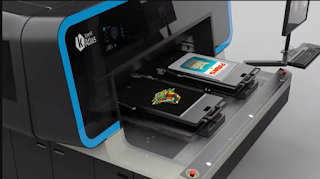It was my first time attending the 2019 Additive Manufacturing Conference (August 27-29) in Austin, TX, which is presented by our sister publication, Additive Manufacturing, and polymer AM was definitely a focus.
For instance, Bonnie Meyer, application engineer at Evolve Additive Solutions, discussed the company’s Selective Thermoplastic Electrophotographic Process (STEP), which combines an existing 2D printing technology with its own proprietary STEP platform. In May, Evonik and Evolve Additive Solutions announced a joint development agreement where the companies will work together to formulate Evonik’s thermoplastic materials to be used in Evolve's (STEP) technology. Meyer said that “system is built from the ground up for production parts and will be targeting mid to low volume parts.” Evolve’s STEP technology will sit alongside traditional manufacturing processes, such as injection molding on the manufacturing floor. The selective thermoplastic electrophotographic process from Evolve is still in the alpha development stage and is expected to be commercial in late-2020.
And one of the biggest benefits of attending a conference is meeting with companies. In this case, I met with both Essentium and EOS to learn more about the company’s solutions and use of plastics in AM.
A Focus on Materials
Austin, Texas-based Essentium manufactures and delivers industrial 3D printers and materials. The company’s Essentium High Speed Extrusion (HSE) Platform is a 3D printing system that reportedly prints parts 10 times faster than conventional Fused Filament Fabrication (FFF) printers by utilizing a non-slip, high torque extruder system and all linear motors.
The company’s FlashFuse technology utilizes a plasma heat source to conduct electricity through a network of carbon nanotubes integrated into Essentium’s Ultrafuse materials. This reaction in turn welds each layer as it is deposited, thus creating a stronger bond that reportedly achieves the tensile strength of injection molded thermoplastics.
Applications include producing high-performance machine parts, tools and jigs and fixtures in aerospace, automotive and electronic manufacturing sectors.
Brandon Sweeney, co-founder and head of R&D of materials for Essentium, said the company is very much focused on materials. At the beginning of the year, Essentium raised $22.2 million in Series A funding led by BASF Venture Capital with participation from Materialise, Genesis Park and previous seed round investors. The two companies extended their strategic partnership to establish a consistent global materials supply chain supportive of Essentium’s HSE platform.
Read more
For instance, Bonnie Meyer, application engineer at Evolve Additive Solutions, discussed the company’s Selective Thermoplastic Electrophotographic Process (STEP), which combines an existing 2D printing technology with its own proprietary STEP platform. In May, Evonik and Evolve Additive Solutions announced a joint development agreement where the companies will work together to formulate Evonik’s thermoplastic materials to be used in Evolve's (STEP) technology. Meyer said that “system is built from the ground up for production parts and will be targeting mid to low volume parts.” Evolve’s STEP technology will sit alongside traditional manufacturing processes, such as injection molding on the manufacturing floor. The selective thermoplastic electrophotographic process from Evolve is still in the alpha development stage and is expected to be commercial in late-2020.
And one of the biggest benefits of attending a conference is meeting with companies. In this case, I met with both Essentium and EOS to learn more about the company’s solutions and use of plastics in AM.
A Focus on Materials
Austin, Texas-based Essentium manufactures and delivers industrial 3D printers and materials. The company’s Essentium High Speed Extrusion (HSE) Platform is a 3D printing system that reportedly prints parts 10 times faster than conventional Fused Filament Fabrication (FFF) printers by utilizing a non-slip, high torque extruder system and all linear motors.
The company’s FlashFuse technology utilizes a plasma heat source to conduct electricity through a network of carbon nanotubes integrated into Essentium’s Ultrafuse materials. This reaction in turn welds each layer as it is deposited, thus creating a stronger bond that reportedly achieves the tensile strength of injection molded thermoplastics.
Applications include producing high-performance machine parts, tools and jigs and fixtures in aerospace, automotive and electronic manufacturing sectors.
Brandon Sweeney, co-founder and head of R&D of materials for Essentium, said the company is very much focused on materials. At the beginning of the year, Essentium raised $22.2 million in Series A funding led by BASF Venture Capital with participation from Materialise, Genesis Park and previous seed round investors. The two companies extended their strategic partnership to establish a consistent global materials supply chain supportive of Essentium’s HSE platform.
Read more

No comments:
Post a Comment
Note: Only a member of this blog may post a comment.